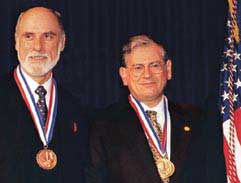

The Internet
resulted from as a research experiment to link computers at scientific
laboratories, so that researchers there could share computer resources. Today
millions use the Internet and it has revolutionized our society, economy and
technological systems. In 1957, the USSR launched Sputnik (the first satellite
in space) and the US considered this as a threat to its country. DARPA
(Defense Advanced Research Projects Agency) was born to ensure that the US
would keep up with the latest technology.
In 1969, DARPA funded a project to develop a high speed, packet
switching communications network to link its research centers and
laboratories. Led by Larry Roberts, this was called the ARPANET. Within a few
years the ARPANET
was up and running in many universities across the United States. In
addition, around the same time other networks were emerging around the world
such as SATNET (Satellite Network) and packet radio. It would be at DARPA
where a new set of protocols would be developed to join these networks
together to form the Internet as we know it today. Robert Kahn and Vinton Cerf
developed the Internetworking protocols: TCP/IP (Transfer Control
Protocol/Internet Protocol), which allowed different networks to join
together.

Vinton Cerf & Robert Kahn
(Source: courtesy of living
internet.com)

TCP/IP is a suite of protocols that allows networked computers
to communicate, it does not matter whether they are part of the same network
or are attached to separate networks. TCP/IP is not just one protocol, but
several. That is why it is referred to as a protocol suite. The TCP/IP suite
is composed of layers, which are:
| Application |
Telnet,
FTP, RPC, etc |
| Transport |
TCP, UDP |
| Network |
IP, ICMP,
IGMP |
| Link |
Network
interface and device driver |
- The link layer is
responsible for communicating with the actual network hardware (e.g., the
Ethernet card).
- The network layer is responsible for
figuring out how to get data to its destination.
- The transport layer provides error
detection and correction.
- The application layer is where the user
typically interacts with the network. This is where telnet, ftp, email,
IRC, etc. reside.
- Internet Protocol (IP) is the central protocol in the TCP/IP
suite. It provides the basic delivery mechanism for packets of data
sent between all systems on an internet, whether the systems are in the
same room or on opposite sides of the world. All other protocols in the
TCP/IP suite depend on IP to carry out the function of moving packets
across the Internet.
- Transmission Control Protocol (TCP) provides a reliable byte-stream
transfer service between two endpoints on an internet. TCP depends on IP
to move packets around the network on its behalf. IP is unreliable so
TCP protects against data loss, data corruption, packet reordering and
data duplication by adding checksums and sequence numbers to transmitted
data and on the receiving side, sending back packets that acknowledge
the receipt of data.

(Source: courtesy of Google)
Over the past century and a half, important technological
developments have created a global environment that is drawing the people of
the world closer and closer together. TCP/IP's
influence on the development of the Internet is responsible for the Global
interconnection of hundreds and thousands of computers. It is
estimated that about 60 million host computers on the Internet today serve
about 200 million users in over 200 countries and territories. The Internet
is growing at a rate of about a new network attachment every half-hour,
interconnecting hundreds of thousands of networks.






![]()
![]()
![]()